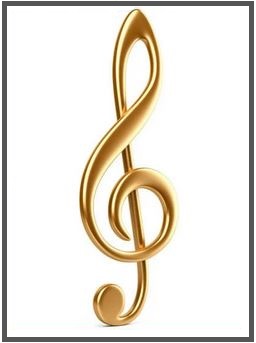 Let’s apply Mr Rogers’ earlier question to reading staff notation. “What do you think about when you read staff notation?” What’s the inner experience of reading music? The conventional description of “reading music” is that you read each note from left to right, one at a time, and play each note as you read it. That’s true, but it’s a two-dimensional view. Simultaneously reading and playing music is a complex mental process.
Let’s apply Mr Rogers’ earlier question to reading staff notation. “What do you think about when you read staff notation?” What’s the inner experience of reading music? The conventional description of “reading music” is that you read each note from left to right, one at a time, and play each note as you read it. That’s true, but it’s a two-dimensional view. Simultaneously reading and playing music is a complex mental process.
With practice, you begin to read faster. You eventually reach a point where you’re playing too fast to consciously name each note as you play it. At that point, you stop naming each individual note, yet you are able to somehow continue reading and playing.
How is this possible? Part of the reason is that after reading for a while, you learn how to mentally “chunk” notes together. You may not be doing it deliberately. You might not even realize that you’re doing it.
You reach the point where you’re calculating the scale steps between notes, whether you know that’s what you’re doing or not. This is what allows you to mentally disconnect from the concept of note names, and somehow still continue to read accurately. This is perfectly natural, and it’s a positive sign that you’re getting better as a reader.
When you reach the point where you visually process the notes on the page, but without having to recite each note name as you read, then you attain the “Zen of reading.” The problem is some people can’t get to that point. They feel disoriented the moment they try to let go of their conscious self-awareness of reading. They are permanently limited to reading at tempos which allow them to process each note by name, one note at a time. This can limit their progress as musicians.
Reading music by calculating the scale steps naturally leads to processing notes in chunks. That means you read one note, then you read a chord or a string of other notes by shape, relative to the position of that one note on the staff. Reading in chunks comes naturally because different types of chords and scales have recognizable shapes on the staff, as we saw earlier. Reading in chunks is identifying an individual note, then calculating intervals of subsequent notes based on shape.
If you want to become a better reader, then the constant chatter of note-names in your head has to go eventually. That’s reading in “slow mode.” To read in “fast mode,” you have to learn to process chunks of notes without reciting the names. In your mind, note names are replaced by images which convey the same meaning. You can mentally process images, especially images in chunks, much faster than you can process words or note names. To get good at reading in “fast mode,” you have to know your fretboard or keyboard cold. You have to internalize the note names, scales and intervals on your instrument.
One thing which helps with learning to read music is reading away from the instrument. I recommend using a pen or pencil as a pointer when you’re reading away from the instrument. This helps you to move naturally from identifying only one note at a time, to reading intervals, and absorbing information in chunks.
© 2019, 2020 Greg Varhaug